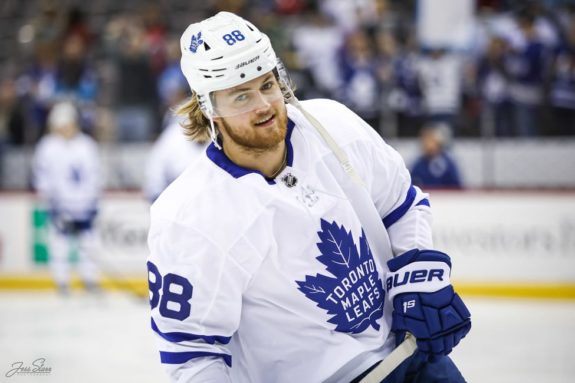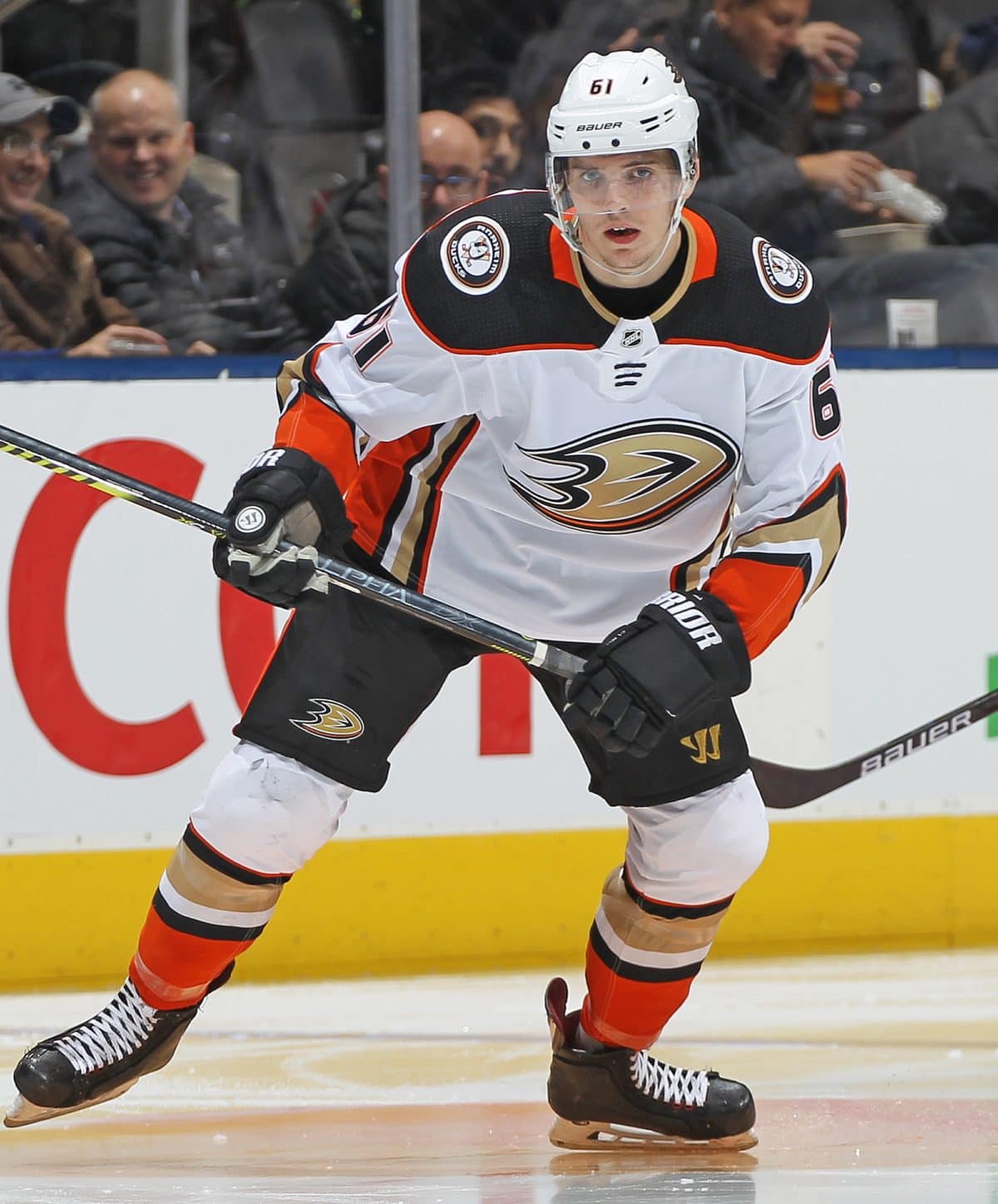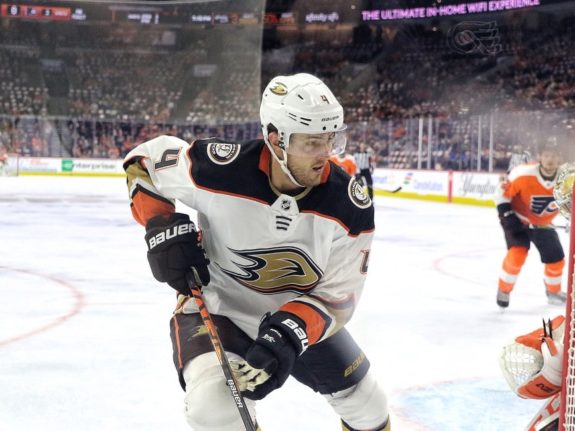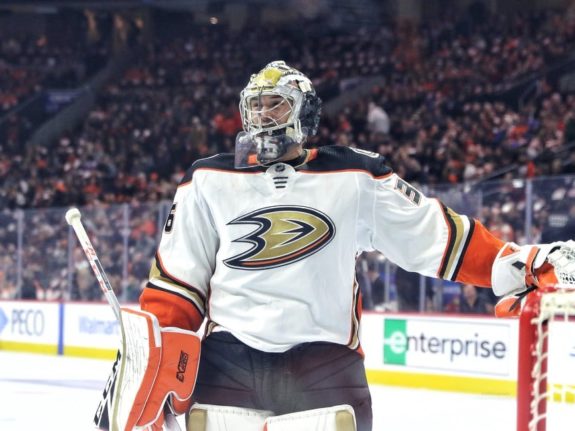
 Stephen Dohner
The Hockey Writers
Stephen Dohner
The Hockey Writers
73
Reads
0
Comments
Ducks’ Offense Can’t Be Cured With Just One Trade
With the Official Start™? of the Official Playoffs™? finally underway, eight more general managers (GMs) are asking themselves what went wrong. For some of those teams, such as the New York Rangers, Minnesota Wild, and Winnipeg Jets, their offseason plans shouldn’t be too significantly altered by what happened in the bubbles. For the Edmonton Oilers and Nashville Predators, while they will correctly consider missing the playoffs a failure, they go into this offseason with largely the same issues they already knew they had.
Then there are the few teams who have spent the last few years making big changes and/or spending significant amounts of money. The Pittsburgh Penguins, Toronto Maple Leafs, and Florida Panthers all head into August looking for ways to address the massively disappointing results of their respective play-in series. While there is no way to know what the future holds, major shake-ups to their respective rosters could be coming. Add in teams like the Buffalo Sabres who have a brand-new regime in charge, a frustrated superstar, and not much else, and things get interesting.
Related: The 5 Best Trades in Ducks History
With the salary cap remaining flat next year and more than a few holes in their lineups, GM’s around the league are going to have to get creative if they decide that changes need to be made. Turning one $10 million a year contract into two or three smaller contracts can make a lot of sense if those expensive players are seen to be underperforming. Or perhaps lost revenue from the pandemic, combined with underwhelming results on ice, leads to a decree from ownership to cut costs. Players like Jack Eichel, William Nylander and Mitch Marner, Jonathan Huberdeau and Aaron Ekblad, could start to see their names pop up in rumors — if they haven’t already.

The Anaheim Ducks, on the other hand, have already had plenty of time to think about where it all went wrong. One of the seven teams not to qualify for the NHL’s restart plan, GM Bob Murray has surely been considering what direction the franchise is headed. Murray has been quite clear on how he regards this season, and what he expects from the Ducks next season. (from ‘Ducks’ Bob Murray expects ‘big step forward’ after disappointing season,’ LA Times, 06/03/2020) The question is, exactly how reasonable an expectation is it? And could they try to capitalize on another team’s growing frustration and impatience to accelerate their rebuild?
Where Do the Ducks Stand
This may seem like a controversial statement, a truly hot take if you please, but I am beginning to think that the Ducks’ roster lacks high-end talent. An Anaheim player hasn’t hit 30 goals in the last two seasons, which coincidentally was the first time the team missed the playoffs in consecutive years since Ryan Getzlaf became captain. On top of that, the Ducks haven’t had two players surpass the 30-goal mark since Corey Perry (43) and Getzlaf (31) managed the feat during the 2013-14 season.
However, a second-round Game 7 loss to the Los Angeles Kings led the Ducks to acquire Ryan Kesler, changing the way they play in the process. For a team that cut its teeth in the league on the back of the high-flying duo of Teemu Selanne and Paul Kariya, that’s not particularly encouraging.
When compared to the teams that qualified for the restart’s round-robin tournament, it’s easy to see just how far behind they’ve fallen. The power play, an issue Anaheim has tried to fix for what feels like forever, has reached satirical levels of ineptitude. The one team in the round robin the Ducks scored more regular season goals than is the Dallas Stars, and they fired their head coach in early December and played over half their season with a new bench boss. In fact, the only statistic where the Ducks net out ahead of the average is games played, and that is a more poignant critique of their offense than just about anything else.
| Games Played | Points | Wins | Goals For | Goal Differential | PP% | |
|---|---|---|---|---|---|---|
| BOS | 70 | 100 | 44 | 227 | 53 | 25.20% |
| STL | 71 | 94 | 42 | 225 | 32 | 24.30% |
| TBL | 70 | 92 | 43 | 245 | 50 | 23% |
| COL | 70 | 92 | 42 | 237 | 46 | 19.10% |
| WAS | 69 | 90 | 41 | 240 | 25 | 19.40% |
| PHI | 69 | 89 | 41 | 232 | 36 | 20.80% |
| VGK | 71 | 86 | 39 | 227 | 16 | 22% |
| DAL | 69 | 82 | 37 | 180 | 3 | 21.10% |
| AVG | 69.88 | 90.63 | 41.13 | 226.6 | 32.63 | 22% |
| ANA | 71 | 67 | 29 | 187 | -39 | 14.70% |
| NET+/- | +1.12 | -23.63 | -12.13 | -39.63 | -71.63 | -7.30% |
Now, don’t get me wrong, this roster isn’t completely devoid of talent. Jakob Silfverberg is one of the best defensive wingers in the league and has developed into a fairly reliable 20-goal scorer. He’s also shown an ability to raise his game in the playoffs where his .53 regular-season points-per-game rate rises to .72. Adam Henrique has proven to be a perfectly fine middle-six center who has eclipsed the 40-point mark in both of his full seasons in southern California. Acquired to stabilize a depleted center core when a rash of injuries struck the team during the first half of the 17-18 season, he has performed well but not exceptional.
Likewise, Rickard Rakell has found success after shifting to the wing and seemed to be on his way to establishing himself as a potent goal scorer. Anaheim fans may have gotten a bit carried away with their hopes on that one. As Getzlaf has aged out of his most impactful seasons and true number one center status, Rakell has seen his numbers affected the most. Randy Carlyle, Bob Murray, and Dallas Eakins have all moved him up and down the lineup trying to help him regain his previous form. They have had limited success to put it nicely.
Forward prospects such as Sam Steel, Isaac Lundestrom, Max Jones, and Troy Terry all seem to have the potential to become legitimate NHL contributors. But outside of Trevor Zegras, there doesn’t seem to be anyone who has first-line talent. If everything goes right and he reaches his 110% version, then maybe Steel can be a high-end, second-line center.

Think along the lines of a more modern, and far less physical, Kesler. But at this point, if he manages to develop into a Henrique proxy, the Ducks would take it. Terry has probably the highest offensive upside of the group, but that’s not really saying a whole lot. Twenty goals and 40 to 50 points would be seen as a major success by the organization.
Unfortunately, the truth seems to be that Anaheim’s current crop of forwards is comprised of supporting pieces and lacks a true offensive cornerstone. While those players have significant value, they can’t replicate the impact of truly elite-level forwards. With Getzlaf aging and expectations being adjusted elsewhere in the lineup, Anaheim doesn’t have any impact forwards at the ready.
| 10-19 Goals | 20-29 Goals | 30+ Goals | 20-29 Points | 30-39 Points | 40+ Points | |
|---|---|---|---|---|---|---|
| BOS | 5 | 4 | 0 | 3 | 3 | 5 |
| STL | 8 | 3 | 0 | 5 | 1 | 6 |
| TBL | 6 | 3 | 1 | 1 | 4 | 7 |
| COL | 7 | 2 | 1 | 9 | 4 | 5 |
| WAS | 4 | 3 | 1 | 3 | 1 | 7 |
| PHI | 5 | 4 | 0 | 5 | 2 | 6 |
| VGK | 3 | 3 | 1 | 1 | 2 | 6 |
| DAL | 6 | 1 | 0 | 6 | 6 | 1 |
| AVG | 5.5 | 2.875 | 0.5 | 4.125 | 2.875 | 5.375 |
| ANA | 3 | 2 | 0 | 5 | 1 | 3 |
| NET +/- | -2.5 | -0.875 | -0.5 | +0.875 | -1.875 | -2.375 |
Ducks Defense is Equally Low on Offense
The Ducks’ much-lauded defense corps isn’t quite the embarrassment of riches it was a few years ago, much to many fans’ dismay. But the fact remains that it’s still, well, pretty good. Hampus Lindholm has proven to a high-end, shutdown defenseman with good skating, good vision, and great instincts. Unfortunately, he lacks the offensive upside that has come to define the upper tier of elite defensemen in this league. Josh Manson is a bit of a mixed bag at this point.
He is exactly what he’s always been, a big, physical, stay-at-home type who epitomizes the “tough to play against” axiom GMs seem to love so much. The problem for Manson has been in stints away from Lindholm — he has looked far from the rock-solid, top-four defenseman he seemed to be not two years ago.
Related: Anaheim Ducks’ 5 Worst Trades in Franchise History
Cam Fowler is an incredibly gifted skater who excels in transition with the puck on his stick. He had one of his best seasons this year after being paired with fellow 2010 draftee Erik Gudbranson. While the trade for Gudbranson cost the Ducks basically nothing, it was rightly criticized given his play and contract. Yet, somehow, two defensemen who never quite lived up to expectations managed to create an effective second pair for Anaheim. Much like the Lindholm-Manson pairing, Fowler and Gudbranson are a nice combination of skating, size, and grit.

Yet, none of Anaheim’s defensive prospects project out as a true number one defenseman. Combined with the fact that none of the assumed top four have finished anywhere near a top-five Norris candidate, the talent deficiency becomes quite obvious. While the position isn’t a barren wasteland, it definitively lacks a truly elite-level contributor.
John Gibson Can’t Do It Alone
Perhaps the only player on the Ducks’ roster that has a chance to win regular-season hardware any time in the near future is John Gibson. After some concerns about his durability early in his career, concerns that proved to be largely unfounded, Gibson has become Anaheim’s undoubted number one goaltender. He has proven himself more than capable of playing at a level befitting in-depth player profiles from The Hockey News and arguably Bob Murray’s greatest quote: “John Gibson is not getting traded … put that [expletive] out there.”

Ultimately, that’s not enough. Gibson started out the 2018-19 season with an absolutely astounding run of play. Despite a truly awful performance from the team in front of him, Gibson managed to play his way into the Hart Trophy conversation. But in the end, the wheels fell off the wagon. Unable to get any kind of production from the rest of the roster, the Ducks imploded and began their descent into the NHL basement. Even if he had managed to keep it up for the rest of the regular season, that level of play is simply unsustainable. One need only look at 2019-20 Hart finalist Connor Hellebuyck and Winnipeg’s early exit from the NHL restart.
Ducks Need More Than Final Piece
So, what can the Ducks front office do about this? Well, the obvious answer is to take advantage of the uncertainty and frustration boiling up around the league. Adding a player like Eichel (68 games played, 36 goals, 78 points) or Nylander (68 games played, 31 goals, 59 points) would certainly go a long way to addressing Anaheim’s lack of top-end skill. With two picks in this year’s first round, expiring contracts like David Backes or Gudbranson, or quality players on team-friendly contracts like Rakell, Lindholm, and Manson, Bob Murray surely has the goods to work his way into those conversations.
Trading for any of these players on their current contracts would firmly and emphatically cement Anaheim as a win-now team and would be looked at as a major signal of intent from management and ownership. The problem there is, while the Ducks have an encouraging group of role players and prospects, one — and honestly, probably both — of them would be weakened in any potential trade. It doesn’t make any sense to trade for an Eichel or a Marner at $10-plus million a year if getting them inherently weakens your ability to maximize their talent.
So, while Anaheim has the goods to go out and swing a trade for an impact player, they probably don’t have the goods to make a second supplementary trade. And to be honest, even if they found a way, the remaining roster would then lack the necessary talent to support them. The truth is, and this is especially true in today’s NHL, it takes more than one or two great players to win a Stanley Cup. Don’t believe me? Just go ask Jason Botterill and Dale Tallon.
The post Ducks’ Offense Can’t Be Cured With Just One Trade appeared first on The Hockey Writers.
Popular Articles

















































 Blackhawks Chicago
Blackhawks Chicago Panthers Florida
Panthers Florida Penguins Pittsburgh
Penguins Pittsburgh Rangers New York
Rangers New York Avalanche Colorado
Avalanche Colorado Kings Los Angeles
Kings Los Angeles Maple Leafs Toronto
Maple Leafs Toronto Bruins Boston
Bruins Boston Capitals Washington
Capitals Washington Flames Calgary
Flames Calgary Oilers Edmonton
Oilers Edmonton Golden Knights Vegas
Golden Knights Vegas Islanders New York
Islanders New York Sabres Buffalo
Sabres Buffalo Red Wings Detroit
Red Wings Detroit Senators Ottawa
Senators Ottawa Lightning Tampa Bay
Lightning Tampa Bay Flyers Philadelphia
Flyers Philadelphia Devils New Jersey
Devils New Jersey Hurricanes Carolina
Hurricanes Carolina Blue Jackets Columbus
Blue Jackets Columbus Predators Nashville
Predators Nashville Wild Minnesota
Wild Minnesota Blues St. Louis
Blues St. Louis Stars Dallas
Stars Dallas Jets Winnipeg
Jets Winnipeg Mammoth Utah
Mammoth Utah Sharks San Jose
Sharks San Jose Canucks Vancouver
Canucks Vancouver Ducks Anaheim
Ducks Anaheim






